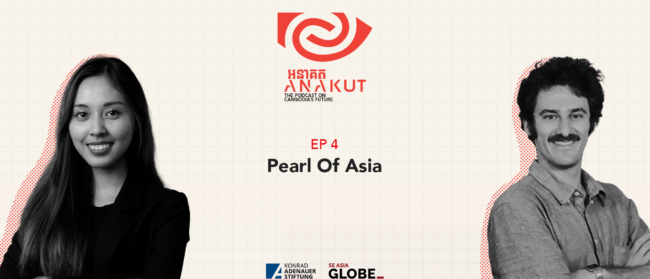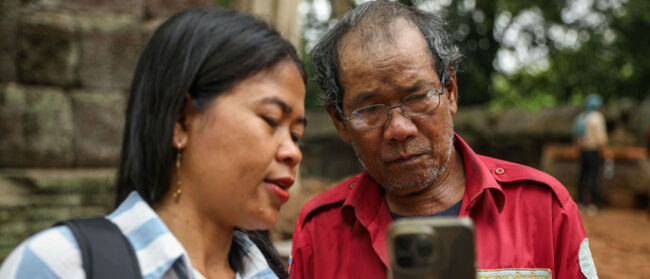As the call to prayer echoes off the white walls of the mosque, the congregation folds like a pair of clasped hands. When the noon prayer begins, the robed figures bow their heads in silent reverence and kneel before their God. On the wall before them hangs a gilded portrait of the Kaaba, the black house of God in the heart of the holy city of Mecca that all Muslims bend toward in their daily worship.
Sitting around a table after the final worshipper has filed out through the arched doors, a group of men in a mixture of Malay- and Middle Eastern-style robes described the mosque as a way station for travellers on the road between Phnom Penh and the provinces.
“No matter where you come from, you can always stop here,” said an elderly man who gave his name as Mohammad.
Rebuilt after the Khmer Rouge period in 1987 with Kuwaiti funds and private donations from Muslim communities spread across Southeast Asia, Nourussalaam Mosque is one of dozens of shining houses of worship lining Cambodia’s National Highway 5. The road stretches north from Phnom Penh to Kampong Chhnang and Kampong Cham, major hubs of the nation’s ethnic Cham community. Tracing their descent from the ancient kingdom of Champa in modern-day Vietnam, the more than 400,000 Chams who live in Cambodia have become the most visible face of Islam in the country. But as private and government funding from Muslim countries across the world continues to facilitate the spread of fundamentalist forms of Islam in this community, it is a face that is looking increasingly unfamiliar to the Buddhist majority.
Since the 9/11 attacks on the US focused the world’s gaze on Islamic extremism, Cambodia’s Muslims have also found themselves under increased scrutiny from both within and outside the country. A January 2010 diplomatic cable from the US chargé d’affaires, leaked the following year by WikiLeaks, urged positive engagement with the Cham community, describing members of the minority as potentially “susceptible to money, ideology, and influence from beyond its borders”.
“…susceptible to money, ideology, and influence from beyond its borders”.
Leaked US diplomatic cable on Cambodia’s Cham muslims in 2010
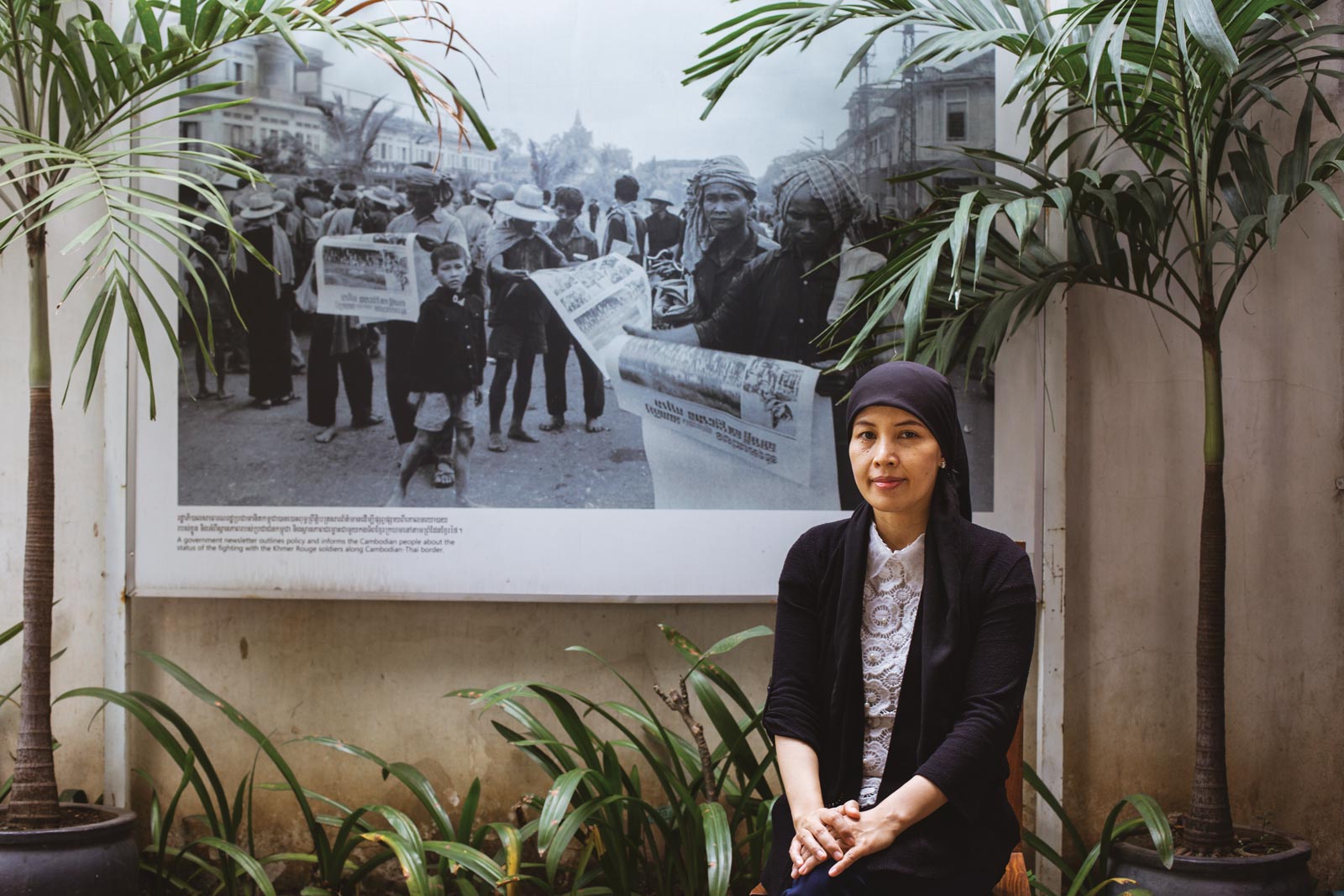
“Cambodia’s Cham live in extreme poverty and have low education levels, high illiteracy rates, and poor health indicators,” it read. “Cambodia also has porous borders, rampant corruption, easy access to forged documents and black-market weapons, and weak rule of law. All of these factors work together to make Cambodia an attractive haven for criminals and extremists, and make the Cham, especially the unemployed youth, susceptible to the potential of radicalisation and violent extremism.”
The 2003 arrest of Indonesian terrorist leader Riduan “Hambali” Isamuddin, accused of masterminding the 2002 Bali terror attacks and closely linked to more than two dozen teachers at a school in Cambodia’s Kandal province funded by a Saudi charity, did little to ease the growing tension. Then, in 2014, the terror group Isis – which has pushed strongly for Muslims from around the world to join its fight to establish a global caliphate – said several of its members had come from Cham communities in Cambodia, although this claim remains unsubstantiated.
Farina So, head of the Cham oral history project at the Documentation Centre of Cambodia, said the rise of Isis could widen a rift between Muslims and Buddhists in Cambodian society.
“Isis might be the most severe factor that contributes to this problem, because [non-Muslim Cambodians] saw through videos on Facebook, social media, how Isis kills people and how they intertwine with religion, with Islam,” she said. “They tend to generalise Muslims as bad in their perceptions.”
Unless there is a concerted effort to encourage greater integration and understanding between Chams and people from non-Muslim backgrounds, So said, the harmony and religious tolerance so often lauded by Cambodia’s government could give way to conflict.
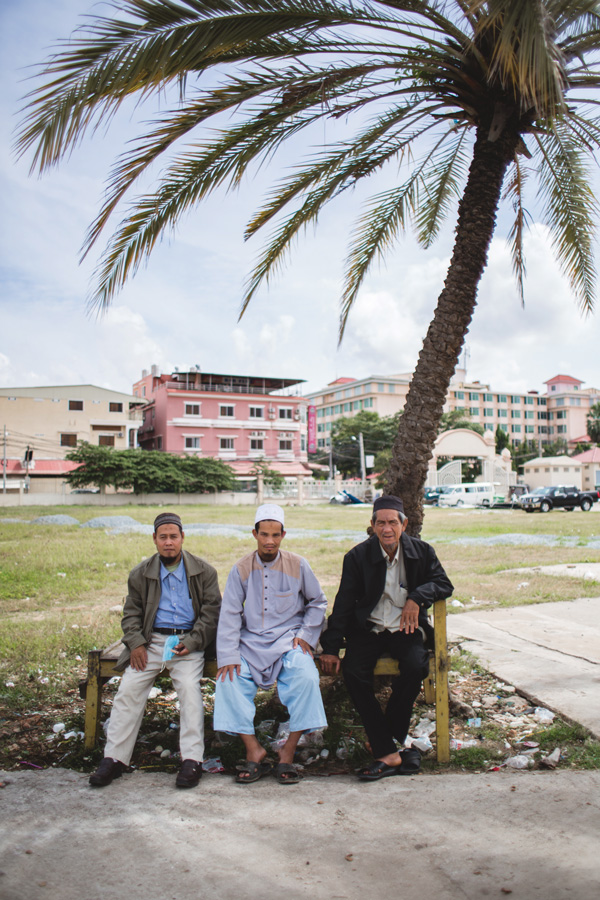
“For the older generation, at least they have some kind of connection [between] Muslim and non-Muslim,” she said. “They know their history, they also suffered under the Khmer Rouge together and they’re carrying the kind of identity called ‘survivor’s identity’. I worry about younger generations – of course they have education, but if they lack consciousness and harmony then it could cause violence, or any kind of thing, in the future.”
Influenced by Middle Eastern reformist movements that condemn modern iterations of Islam as decadent and detached from the teachings of the Prophet Mohammad, many Cham communities have begun to practise a strict separation of the sexes and have discarded their traditional dress for Middle-Eastern attire. In some areas, this shift has seen women put aside lighter headscarves for more restrictive forms of hijab including, in some cases, the niqab, a veil that leaves just the eyes visible, favoured by the Saudi-born Wahhabi movement.
In his book, Making Modern Muslims: The Politics of Islamic Education in Southeast Asia, Norwegian researcher Bjørn Atle Blengsli described a tense relationship between “true” Islam and the historic traditions, language and practices unique to the Chams.
“Most Cambodian Muslims… have a narrow and unfavourable understanding of local ‘culture’; they see it as something that pollutes true Islam,” he wrote. “The process of deculturation also impacts Muslim views of their non-Muslim neighbours.”
It is perhaps with this mindset that donors from several Gulf States – Kuwait, Qatar, the United Arab Emirates and Saudi Arabia – have poured millions into rebuilding the Islamic infrastructure of Cambodia’s Cham communities in the decades following the fall of the Khmer Rouge. Some of this money has come from the oil-rich regimes directly, with Kuwait alone setting aside $5m for the development of new mosques and Islamic schools from a soft loan of almost $550m in 2008, just months after the emirate of Qatar pledged $200m for Cambodia’s farmlands.
More difficult to gauge has been the full extent of the funding flowing from the coffers of private organisations such as the Salafist Revival of Islamic Heritage Society or the Kuwaiti International Islamic Charity Organisation. With that money has come a fresh wave of reformist movements from the Middle East pushing their own hardline interpretations of Islam. The main branches, the proselytizing Jama’at Tabligh – known in Cambodia as Dakwah Tabligh – and the fundamentalist Wahhabi movement, have both set up their own networks of dozens of Islamic day schools and boarding schools in Cambodia’s provinces as detailed by Blengsli and his researchers. Stocked with Arab-sourced teaching materials and staffed by teachers educated abroad, they remain dedicated to bringing a new generation of Cambodian Muslims into the fold.
Emiko Stock, an anthropologist and ethnographer who has studied Cambodia’s Cham community for more than 16 years, said the growing number of Islamic schools have given many young Cham people, particularly girls and women, access to a level of education they would otherwise have missed out on.
“The veneer [of the Dakwah] is about going back to Mohammad and the time when everything was right, but there is another appeal behind it,” she said. “The same for the Wahhabi – if you go to a Wahhabi school you get a secure, a religious, but also a very strong, secure education that would be much more difficult or costly to get at a Cambodian school. But for the non-Muslim [community] there are critics… even for some Chams themselves.”
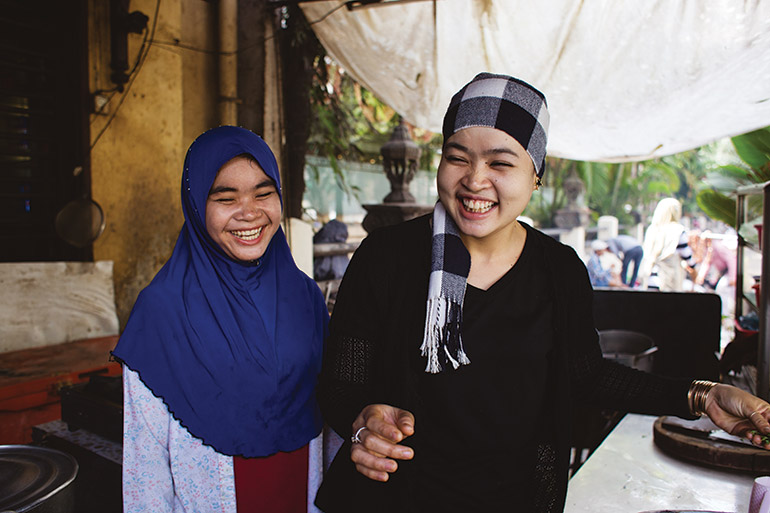
So said that overseas funding often came with stringent conditions designed to pressure traditional communities to conform to “pure” Islamic thought. “When [Cham leaders] want to develop their community, the funding from Muslim countries or Islamic countries tends to put some conditions that they should convert to Islam – real Islam, true Islam – pray five times a day and things like that,” she said. “Some members would accept, some would not, because… they fear losing their identity again because they suffered this during the Khmer Rouge time.”
For the Cham, the nearly four years under the Khmer Rouge regime have left deep scars. In addition to the widespread murder, rape and abuse suffered at the hands of the ultra-Maoist regime, testimony from survivors describes Muslims forced at gunpoint to eat pork and mosques converted into pigsties and torture pits. The exact number of dead – or, even, how many were alive at the advent of the regime – remains contentious: historian Ben Kiernan has placed the death toll at about 87,000, while Cham researcher Ysa Osman insists that as many as 500,000 lost their lives – a figure twice the size of the most commonly cited estimate of the Cham population in 1975. Countless holy books, histories and poems preserving the history and practices of the Cham people were burned to make way for the regime’s nightmarish utopia. It is in the legacy of this devastation, So said, that the seeds of the current influx of foreign funding were planted.
“We rarely get donations from Middle Eastern donors because they say we don’t practise like Muslims,” he said. “They say we are more Cambodian than Muslim.”
Sou Ly, Iman San tribe
“It’s about demand and supply,” she said. “People felt that their identity was lost during the Khmer Rouge times, especially their Islamic and cultural identity. So they feel the need to revive Islam and to have mosques, education, to connect with the larger world – not to be a minority within a minority country. They want to be well connected with the larger world, to have a sense of a global Islamic identity – that’s why they also reach out to those countries, Gulf countries and Muslim countries in Southeast Asia.”
In Kampong Chhnang’s Chan Kiek village, elder Sou Ly of the dwindling Iman San tribe – a minority of some 35,000 within the wider Cham community – said his people have been left behind in his countrymen’s rush to join the ranks of the global Islamic community. “We rarely get donations from Middle Eastern donors because they say we don’t practise like Muslims,” he said. “They say we are more Cambodian than Muslim.”
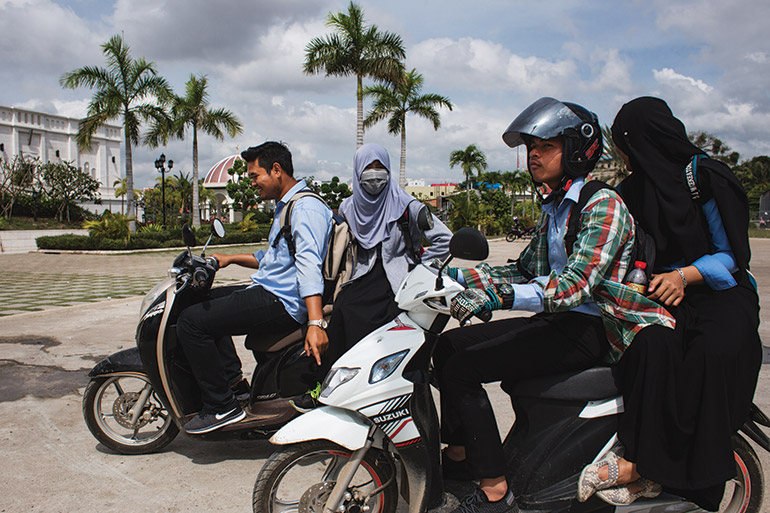
Devoted to the teachings of a 19th century religious leader, the Imam San practise a syncretic form of Islam that is heavily influenced by the animist traditions of Southeast Asia. In one of their ceremonies, mediums reel and dance with possessed fury, blunted weapons in their hands. Perhaps most troublingly for proponents of a return to the early days of the Prophet’s teachings, the Imam San traditionally pray just once a week, on Fridays, neglecting the strict Muslim practice of prayer five times a day.
For Ly, the idea of sacrificing his traditions in return for steady patronage is unthinkable. “We can’t get funding, because we want to preserve our culture,” he said. “It would be like losing my people again.”
Despite fears that the so-called ‘Islamisation’ of Cambodia’s Muslim communities could see centuries-old traditions forgotten, Stock suggested that many members of the Cham community were not so quick to discard their old beliefs.
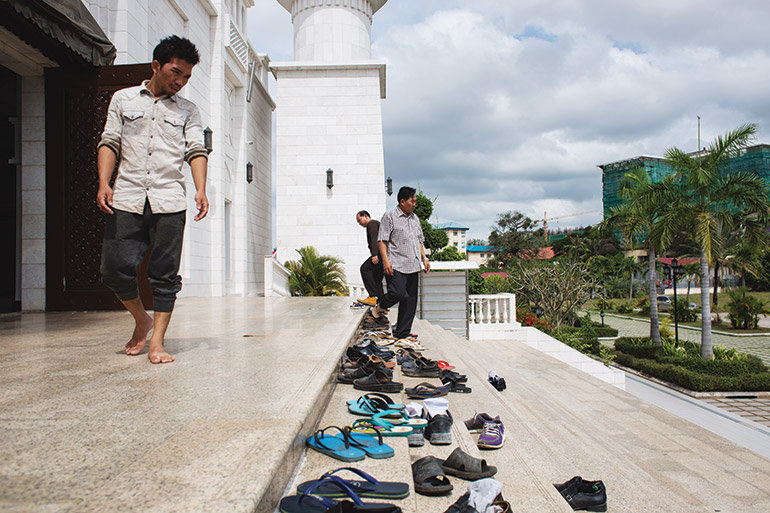
“The Middle Eastern influence is very much visual because it comes with a lot of money, but it’s not necessarily anchored,” she said. “People try things out all the time – you can meet people in a village and they say we’re all Dakwah, and two years, not even two years, after that they’re more interested in the Wahhabi trend, because the Wahhabis are building them a school. In a few years from now, the Wahhabi school may be completely [diminished], because people are maybe not so interested anymore.”
According to Stock, this is a testament to the endurance of a Cham identity that remained resolute even in the darkest days of the Khmer Rouge. “When you look deeper, even in villages that are very [much] strongholds of the Dakwah, places like that… you still have procession ceremonies at the back of a house without the imam knowing – or without the imam wanting to know or acknowledge it,” she said.
As the final worshippers filed out of Nourussalam Mosque, Mohammad brushed aside the suggestion that Cambodia’s Muslim communities were shrinking further away from mainstream Khmer society as they adopt increasingly alien practices. “We all come from the same God,” he said. “We study the same God through the Prophet.”

